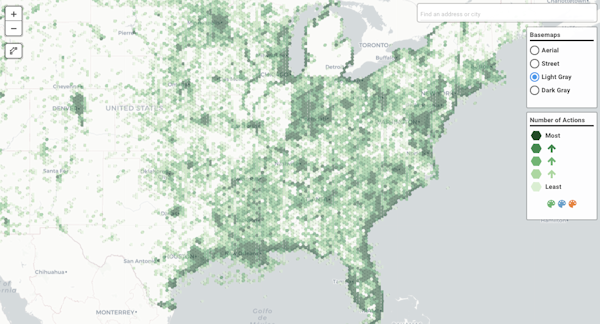SEJournal Online is the digital news magazine of the Society of Environmental Journalists. Learn more about SEJournal Online, including submission, subscription and advertising information.
 |
 |
| Tracking federal permits needed to dredge and fill wetlands is made easier with an Army Corps of Engineers permit finder database. Above, a screenshot showing a map of permit activity in the eastern United States. Image: Army Corps of Engineers website. |
Reporter’s Toolbox: Dredging for Data on Wetlands Permits
By Joseph A. Davis
Second of two parts on wetlands and Section 404. Read part one.
One way for environmental journalists to dig up local controversy is to look into the federal permits needed to “dredge and fill” wetlands. Fortunately, there’s a database for that.
Even if nobody is holding press conferences or threatening to sue, you can find stories about how land development and infrastructure construction may be impacting the waters and other natural resources around you.
SEJournal has previously outlined some of the big legal issues and story ideas you can pursue related to wetland permits. These permits are often required by Section 404 of the Clean Water Act, so we’ll just call them 404 permits.
Where the data come from
The data we want to share comes from the Army Corps of Engineers “permit finder.” You can start finding data from this search portal.
The slight problem is that the ability to do user-friendly web design appears to have been lost in the swamp. So go all the way to the bottom of the page and click on the teensy shaded box that says “Click here to get started looking for permits.”
The Section 404 permit program is administered jointly by the Corps and the U.S. Environmental Protection Agency. But much of the administration of the individual permits themselves is done by the Corps; that’s why they have the data.
The Corps, in its own way, is pretty good with databases (but less so with access to them and user-friendliness). They are, after all, engineers, so we expect them to be accurate (and hard to understand). The Corps updates the data weekly.
How to use the data smartly
What you first get when you click through the search portal is a nationwide map, dotted with points where permits are granted or pending. If you want finer graphic information, you can zoom in.
But if you are a bare-metal coder who wants the raw data itself, you can click the button near the upper right corner that says “Table View.” This gives you a data table in what you might call spreadsheet form. It has all 51,698 permits. The problem is that you have to page through it, which can take forever.
The only way around this obstacle is to “scrape” the data into your own database format of choice. That can require geek skills, too complex to explain here, but you can find tips and tools for scraping here, here and here. Sorry.
Some web browsers and spreadsheets also have tools and extensions to help. Or you could hire someone to do it. Or you could find a collaborator to partner with — one who has scraping skills. (Tell your editor that collaboration is the coming thing.)
But remember: You may want to update the data weekly, so it is good to have a program or app to do the scraping repeatedly.
Maybe you don’t want all that
nationwide data, but rather just
some grist for local wetland
stories. Here, you are in luck.
OK, so maybe you don’t want all that nationwide data, but rather just some grist for local wetland stories. Here, you are in luck.
The map presentation of this database is your friend in that case. You can search/select on geographic criteria — as long as you know what Corps district you are in (the Corps is quite decentralized in many of its functions and works through an extensive network of districts and divisions).
As always, we remind you to groundtruth and update whatever information you can, and to do the real reporting that gives the human dimension to what you are writing about.
[Editor’s Note: See part one, a TipSheet on “Reemerging Wetlands Controversy Brings Local Angles.” For more on wetlands, see a Backgrounder advancing the Supreme Court’s Sackett decision, another Toolbox on tracing wetlands with a land cover database and more TipSheets on a national wetlands inventory and on wetlands mitigation, plus an Inside Story award-winner Q&A on covering wetlands. For current headlines on wetlands issues, check out EJToday.]
Joseph A. Davis is a freelance writer/editor in Washington, D.C. who has been writing about the environment since 1976. He writes SEJournal Online's TipSheet, Reporter's Toolbox and Issue Backgrounder, and curates SEJ's weekday news headlines service EJToday and @EJTodayNews. Davis also directs SEJ's Freedom of Information Project and writes the WatchDog opinion column.
* From the weekly news magazine SEJournal Online, Vol. 8, No. 43. Content from each new issue of SEJournal Online is available to the public via the SEJournal Online main page. Subscribe to the e-newsletter here. And see past issues of the SEJournal archived here.












 Advertisement
Advertisement 



